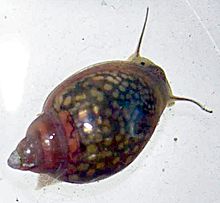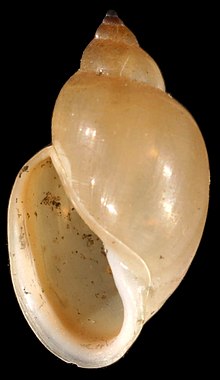Physella acuta
| Physella acuta | |
|---|---|

| |
| Physella acuta | |
NE[1]
| |
| Scientific classification | |
| Kingdom: | |
| Phylum: | |
| Class: | |
| Superfamily: | |
| (unranked): | |
| Family: | |
| Subfamily: | |
| Tribe: | |
| Genus: | |
| Species: | P. acuta
|
| Binomial name | |
| Physella acuta (Draparnaud, 1805)[2]
| |
| Synonyms | |
|
Physa acuta Draparnaud, 1805 | |
Physella acuta, common name the European physa, is a species of small, left-handed or sinistral, air-breathing freshwater snail, an aquatic pulmonate gastropod mollusk in the family Physidae.
Shell description

Snails in the family Physidae have shells that are sinistral, which means that if the shell is held with the aperture facing the observer and the spire pointing up, then the aperture is on the left-hand side.
The shells of Physella species have a long and large aperture, a pointed spire, and no operculum. The shells are thin and corneous and rather transparent.
Distribution
It was thought that indigenous distribution of Physella acuta is Mediterranean.[4][5] But if Physella heterostropha is a synonym, then as its indigenous distribution is considered as North-American.[6]
Physella acuta is the common species, which has invaded practically all fresh waters of the world, and is common in eastern part of North America and Europe. The species seems to have first spread through Mediterranean regions and then more slowly into northern Europe.[3][6]
In Europe
- Croatia
- Czech Republic - not evaluated (NE) [7]
- Germany[8]
- Netherlands[9]
- Pripyat River since 1983 and in Neman River basin in Belarus since 2007[6]
- and others
The distribution also includes Mediterranean regions and Africa.[10]
In America
The distribution includes the United States: Maryland, New Jersey, and Virginia. The initial introduction in the United States was probably from aquarium release, aka "aquarium dumping".[10]
Ecology
Habitat
This species lives in freshwater rivers, streams, lakes, ponds, and swamps.[10]
Physella acuta is frequently found in anthropogenic reservoirs, occurring in warm water discharges from power stations and in some rivers, but very rarely and not numerously in clay pit ponds. It can survive well under temporary harsh conditions (extreme temperature and water pollution), as long as they are short-lived.[6]
Feeding habits
These snails eat dead plant and animal matter and various other detritus.
While Physella acuta forages mainly on epiphytic vegetation and on the macrophytes, other gastropods (Planorbis planorbis, Radix ovata) xploits the algal cover or phytobentos on the bottom. Therefore competition between Physella acuta and other gastropods appears to be minimal.[6]
Interspecific relationship
This species successfully co-exists with other alien gastropods: for example with Potamopyrgus antipodarum in many streams, lakes and ponds in New Zealand and with Lithoglyphus naticoides in the Danube River.[6]
References
This article incorporates CC-BY-2.0 text (but not under GFDL) from reference [6].
- ^ 2006 IUCN Red List of Threatened Species. <www.iucnredlist.org>. Cited 30 April 2007.
- ^ Draparnaud J.-P.-R. 1805. Histoire naturelle des mollusques terrestres et fluviatiles de la France. Ouvrage posthume. Avec XIII planches. pp. [1-9], j-viij [= 1-8], 1-134, [Plates 1-13]. Paris, Montpellier. (Plassan, Renaud).
- ^ a b c Dillon R. T., Wethington A. R., Rhett J. M. & Smith T. P. 2002. Populations of the European freshwater pulmonate Physa acuta are not reproductively isolated from American Physa heterostopha or Physa integra. Invertebrate Biology, 121: 226-234. (abstract)
- ^ Template:Sk icon Lisický M. J. 1991. Mollusca Slovenska [The Slovak molluscs]. VEDA vydavateľstvo Slovenskej akadémie vied, Bratislava, 344 pp.
- ^ Glöer, P. 2002 Die Süßwassergastropoden Nord- und Mitteleuropas. Die Tierwelt Deutschlands, ConchBooks, Hackenheim, 326 pp., ISBN 3-925919-60-0, page 238-239.
- ^ a b c d e f g Vitaliy Semenchenko, Tatiana Laenko & Vladimir Razlutskij. 2008. [http://www.aquaticinvasions.ru/2008/AI_2008_3_3_Semenchenko_etal.pdf A new record of the North American gastropod Physella acuta (Draparnaud 1805) from the Neman River Basin, Belarus]. Aquatic Invasions (2008) Volume 3, Issue 3: 359-360.
- ^ Beran, L. (2002) Vodní měkkýši České Republiky - rozšíření a jeho změny, stanoviště, šíření, ohrožení a ochrana, červený seznam. Aquatic moluscs of the Czech Republic - distribution and its changes, habitats, dispersal, threat and protection, Red List. - Sborník přírodovědného klubu v Uherském Hradišti, Supplementum 10, 258 pp. (in Czech)
- ^ MollBase - Physella acuta - Spitze Blasenschnecke - Atlas 1991
- ^ "Physella acuta". 2005.
- ^ a b c Amy Benson. 2007. Physella acuta. USGS Nonindigenous Aquatic Species Database, Gainesville, FL. http://nas.er.usgs.gov/queries/FactSheet.asp?speciesID=1025 Revision Date: 4/22/2004
Further reading
- Naranjo-García E. & Appleton C. C. (2009). "The architecture of the physid musculature of Physa acuta Draparnaud, 1805 (Gastropoda: Physidae)". African Invertebrates 50(1): 1-11. Abstract
